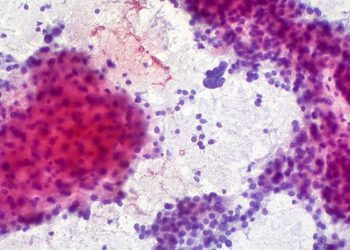Younger adults with extremity soft-tissue sarcoma may be more likely to receive chemotherapy and less likely to receive radiation therapy compared to older adults
1. Age group was not significantly associated with variations in treatment for extremity soft-tissue sarcoma decisions, except for the use of chemotherapy and radiation therapy, where younger patients were more likely to receive chemotherapy and less likely to receive radiation therapy.
2. Additional studies are warranted to correlate the clinical consequences of these treatment disparities among age groups.
Evidence Rating Level: 2 (Good)
Study Rundown: Sarcomas are a type of cancer originating in soft tissues or bone and represent 10% of cancers in the adolescent and young adult population. Despite the number of young patients with sarcoma, this age group is underrepresented in clinical trials owing to factors including cost of care, location, patient education, differing histology, and poor clinical trial participation. The limited data on clinical management in this population has led to poorer outcomes and more complications. This cohort study sought to investigate clinical practice and treatment disparities among young adults compared to older patients with extremity soft-tissue sarcomas (ESS). The main endpoint of the analysis was to identify individual factors associated with treatment decisions in young adults with ESS. Multivariable analysis with logistic regression was used to identify patterns of disease management and their association with demographic and histological characteristics. Among 8,953 patients with ESS, there was no significant difference in the likelihood of receiving amputation vs limb-sparing surgery (LSS) in young adults compared to older patients. However, the study did find that younger patients were more likely to receive chemotherapy and less likely to receive radiation therapy (RT) compared to older patients. Therefore, the results of this study suggested that age group was not significantly associated with variations in treatment decisions, except for the use of chemotherapy and RT, where younger patients were more likely to receive chemotherapy and less likely to receive RT despite controlling for clinical and demographic factors. Additional studies employing prospective design and randomization are warranted to correlate the clinical consequences of these treatment disparities. A limitation of this study was that the presence of comorbidities among patients were not factored into the analysis. Comorbidities could affect the choice of clinical treatment options offered to patients and, thus, may serve as a confounding factor in the analysis especially in older patients with a higher likelihood of comorbidities.
Click to read the study in JAMA Network Open
Relevant Reading: Overview of sarcomas in the adolescent and young adult population
In-Depth [retrospective cohort]: This multicenter retrospective cohort study included 8,953 patients (1,280 [14.3%] young adults, 4,796 men [53.6%], 6,615 [73.9%] non-Hispanic White) from the National Cancer Data Base (NCDB) between 2004 and 2014 with data analysis completed in November 2019. Eligible patients were diagnosed with ESS and received definitive treatment including limb-sparing surgery (LSS) or amputation and separated into young adults (18-39 years) and older adults (≥40 years). Overall, more young adults underwent amputation than older adults (18-39 years, 104/1,280 [8.1%]; 40-64 years, 217/3,937 [5.5%]; ≥65 years, 199/3,736 [5.3%]), however the association was not statistically significant (65 years, OR, 1.49; 95%CI, 1.00-2.23; P = .05). Furthermore, younger patients were more likely to receive chemotherapy than older patients (40-65 years, OR, 0.52; 95%CI, 0.45-0.60; P = .001; ≥65 years, OR, 0.16; 95%CI, 0.12-0.20; P = .001). In contrast, young adults were less likely to receive radiation therapy than older adults (40-65 years, OR, 1.40; 95%CI, 1.22-1.61; P = .001; ≥65 years, OR, 1.33; 95%CI, 1.10-1.61; P = .003). Among young adults, clinical stage II vs stage I disease and positive surgical margins were not associated with the use of radiation therapy (stage II disease: OR, 1.25; 95%CI, 0.81-1.91; P = .31; positive surgical margins: OR, 1.43; 95%CI, 0.93-2.22; P = .11). Lastly, White Hispanic young adults were less likely to receive radiation therapy than non-Hispanic White young adults (OR, 0.53; 95%CI, 0.36-0.78; P = .002).
Image: PD
©2021 2 Minute Medicine, Inc. All rights reserved. No works may be reproduced without expressed written consent from 2 Minute Medicine, Inc. Inquire about licensing here. No article should be construed as medical advice and is not intended as such by the authors or by 2 Minute Medicine, Inc.


![2 Minute Medicine: Pharma Roundup: Price Hikes, Breakthrough Approvals, Legal Showdowns, Biotech Expansion, and Europe’s Pricing Debate [May 12nd, 2025]](https://www.2minutemedicine.com/wp-content/uploads/2025/05/ChatGPT-Image-May-12-2025-at-10_22_23-AM-350x250.png)




